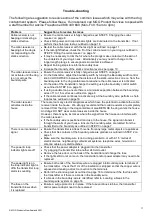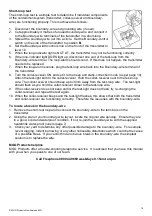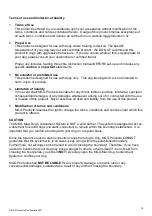
8
© MGG Products New Zealand 2021
STEP 4:
Connecting boundary-wire to the transmitter (4A)
•
Run the boundary-wire to the transmitter. This may require
drilling a hole through a wall, window frame or beneath a door
•
The boundary-wires need to be twisted together to cancel
signals occurring from other electrical sources (see page 7)
•
Strip the ends of the boundary-wire by approximately 1cm and
insert directly into the
RED
boundary-wire terminals of the
transmitter (
4A
)
When the entire system set-up is complete
•
Ensure the boundary-width is set as per STEP 6 page 10
•
Turn the boundary-width control knob on the front of the
transmitter clockwise to 10. This will set the warning zone to
the maximum width
Caution:
Do not turn up the boundary-width to high without
the wires being connected. This will damage the transmitter
•
Plug the 12v power adapter into a mains socket then insert the
other end of the cable into the power-input socket of the
transmitter
•
Both the power light and the loop indicator light should come on. If this does not happen, see
the
‘Troubleshooting’
section (page 17)
Ground wire (
4B
)
If you are not using an anti-surge device, effective grounding is
required to minimise the risk of electrical power surges which can
damage the transmitter and/or power adapter.
To ground the unit:
•
Use a solid (not stranded) ground wire (1 to 1.5mm core
insulated copper wire) with a ground rod and clamp.
These can be obtained at most electrical supply stores
•
Bury the ground rod at least 1-metre deep into the earth in a
location as close as possible to the transmitter
•
Connect one end of the ground wire to the BLACK ground
terminal located on the transmitter and the other end of the
ground wire to the ground rod
Fuse Protection (
4C
)
The transmitter is also equipped with a 250 volt, ½ amp fuse to help
protect the unit’s electronic
circuitry from power surges. To locate the fuse, slide off the lid on the back of the transmitter as
shown in
4C
.






































